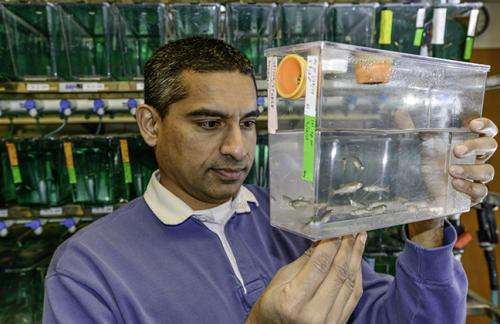Study of zebrafish neurons may lead to understanding of birth defects like spina bifida

The zebrafish, a tropical freshwater fish similar to a minnow and native to the southeastern Himalayan region, is well established as a key tool for researchers studying human diseases, including brain disorders. Using zebrafish, scientists can determine how individual neurons develop, mature and support basic functions like breathing, swallowing and jaw movement. Researchers at the University of Missouri say that learning about neuronal development and maturation in zebrafish could lead to a better understanding of birth defects such as spina bifida in humans.
"We are studying how neurons move to their final destinations," said Anand Chandrasekhar, professor of biological sciences and a researcher in the Bond Life Sciences Center at MU. "It's especially critical in the nervous system because these neurons are generating circuits similar to what you might see in computers. If those circuits don't form properly, and if different types of neurons don't end up in the right locations, the behavior and survival of the animal will be compromised."
The scientists studied zebrafish embryos, which are nearly transparent, making internal processes easy to observe. Using modified zebrafish expressing green fluorescent jellyfish protein, Chandrasekhar and his team were able to track neuronal migration.
"This approach is used extensively to visualize a group of cells," Chandrasekhar said. "In our study, clusters of green cells glowed and indicated where motor neurons were located in the brain. Some groupings are shaped like sausages while others are round, but each cluster of 50 to150 cells sends out signals to different groups of jaw muscles."
These motor neurons that Chandrasekhar studied are located in the hindbrain, which corresponds to the human brainstem and controls gill and jaw movement in these tiny fish. Genes controlling the development and organization of these neurons in zebrafish are functionally similar to genes in higher vertebrates including mammals.
Chandrasekhar's work contributes to a better understanding of how neuronal networks are organized and "wired" during development. These studies also may provide insight into birth defects like spina bifida, which affects 1 in every 2,000 births, according to the National Institutes of Health.
"One of the hallmarks of spina bifida is an open neural tube in the spinal cord," Chandrasekhar said. "The cells closing the neural tube actually know left from right, and front from back, just like the neurons migrating to their appointed places in the zebrafish hindbrain. Additionally, mutations in many genes that result in defective neuronal migration can lead to defects in neural tube closure. We anticipate that understanding the genes and mechanisms controlling neuronal migration in zebrafish will shed light on the mechanisms of human neural tube closure, and why this process goes awry in spina bifida."
Chandrasekhar's study, "Structural and temporal requirements of Wnt/PCP protein Vangl2 function for convergence and extension movements and facial branchiomotor neuron migration in zebrafish" was recently published in February 2014 edition of Mechanisms of Development. He also published a related study, "The PCP protein Vangl2 regulates migration of hindbrain motor neurons by acting in floor plate cells, and independently of cilia function," in the October 2013 edition of Developmental Biology.












